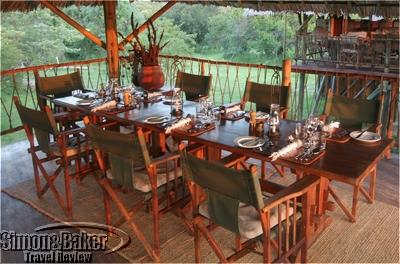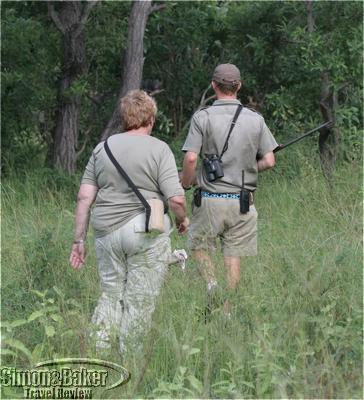
The Selous Safari Camp, offering lake and river access, was attractive and good place for first time safari goers. The area was free of tse-tse flies and home to few disease carrying insects, we were told. This was a big advantage, especially for newbies and families with children who preferred to remain off malaria meds. We liked many of the camp’s features such as the pretty pool area with a shady section, cool lounge and dining areas on stilts and with water views, and our bush style luxury tent near the banks of the lake.
Time between game drives was spent in our tent, usually under the cooling fan that hung above our bed or bird watching on the deck. Selous accommodations were smart, roomy and with an emphasis on the bush. We particularly liked the tent design. Our tent had a high ceiling and spacious interior as well as a shady water facing rear deck from which we spotted a beautiful flycatcher pirouetting the day we arrived. Most Selous guests hailed from Great Britain and Europe and a few were from the United States. This made meal time conversations, while we shared a common table, varied and interesting.
We especially enjoyed a morning bush walk as well as game viewing on Lake Nzerakera and the Rufiji River. Game viewing boat rides with our guide Kandindi were calming and a source of endless wonder. From the comfort of our front seats we saw skittish hippos spraying giant plumes of water before disappearing timidly under the silvery surface; land animals, like antelope and giraffes, drinking on the water’s edge; and myriad birds in varied colors and sizes feeding and flying over the water. When our friends ask us to describe the Selous Safari Camp we mention the hippos feeding at dawn; the brilliant boat excursions, bush walks and game drives in an almost exclusive setting; our comfy and stylish tent accommodations, and the zesty meals we shared with fellow game viewing enthusiasts.
Class Of Accommodation Luxury bush tents
General Manager Claus Becker
Handicapped Access Not wheelchair accessible
Length Of Stay Two nights
Location On an oxbow lake in the photographic safari section of the Selous National Park in Tanzania
Owned-Managed The Selous Safari Company/Charles Dobie
Size There were 10 tents and 50 staff including six guides on the five acre property.
Year Opened-Renovated The property first opened December 1989. The most recent renovation was in 2006 when the whole camp was renovated and upgraded.
Room Our luxury tent (Number 6) was between two other tents and about 250 feet from the banks of the lake. It comprised two distinct areas. There was an outer area of about 1,000 square feet with a thatched roof as well as front and rear wood decks; and an interior tented area occupying about 450 square feet. From almost every vantage point in the tent, we had a clear view of the adjacent grassy area and beyond it Lake Nzerakera.
A rustic style bed, made up of two single beds joined together, occupied the center of the tent. A much appreciated electric ceiling fan (powered by the camp generator when it ran intermittently during the day) hung above the bed. The bed leaned against a wide wood shelf which housed night lamps and a plant. Most of the tent “walls” were of screen material allowing us generous views of the lake and surrounding bush. At night the staff placed privacy covers over the screens. Other wood furniture included a chest at the foot of the bed, a bench in the corner and a handsome freestanding full length framed mirror near the entrance.
An oversize screen opened up onto a lake facing rear deck. Although we seldom had time, we longed to lounge on the deck. In the stifling midday heat, the shade was inviting. There was a desk and chair, love seat, wicker armchair and small coffee table.
All drinks, including bottled water and soft drinks, were priced individually.
Facilities There was a swimming pool, curio shop, bar and indoor dining decks.
Pool Near the camp reception, there was a 12 feet x 30 feet and about 5.5” feet deep pool. There were several lounge chairs in the shade and self service towels. A shade net hung over the pool, keeping it bug free and cool. Lake water was chlorinated and filtered to supply the pool.
During our visit recent rains had caused the roads to be in disrepair. Although the rides were pretty bumpy, our game viewing vehicle had cushy seats that helped soften the ride. We took advantage of all three types of game viewing activities. Unexpectedly, we were at Selous during one of the wettest seasons in recent memory. This meant the river and lake were overflowing and game viewing was challenging.
Our early morning bush walk was in the company of three other guests, Mark Sheridan-Johnson, our South African trained Selous guide, and Makungu, an armed local guide. We walked silently in single file behind Mark while Makungu watched our backs at the rear of the line. Every so often Mark would stop to point out something of interest; at that time we were welcome to ask questions. Although we only spotted a few animals from afar, we saw many animal tracks, dung, and plants, and learned about the bush. During the walk we saw a frog foam nest, a dessert rose flower (also known as an impala lily), bush onions (inedible), ant lion lair, spider hunting a wasp, yellow winged bat, dessert date tree, whistling thorn tree, striped ground squirrel, sandpaper tree, giraffe, and wild basil.
While at Selous we saw the following animals: crocodile, dwarf mongoose, Egyptian mongoose, elephant, hippo, impala, kudu, lions (2 females), monitor lizard, striped ground squirrel, giraffe, waterbuck with young, yellow winged bat, and zebra.
Birds: African darter, African fish eagle, African open billed stork, African sandpiper, African spoonbill, African white backed vultures, black cuckoo, black headed weaver, brown snake eagle, carmine bee eater, cattle egret, common sandpiper, Egyptian geese, golden weaver, goliath heron, gray heron, gray banded heron, ground hornbill, hadida ibis, helmeted guinea fowl, little bee eater, malachite kingfisher, night heron, pied kingfisher, pied wagtail, red billed oxpecker, southern blue crested starling, water thickknee, white breasted sparrow weaver, white browed sparrow weaver, white crowned lapwing, white crowned plover, white throated bee eater, wide swallow, white swallow, woolly necked stork, yellow billed stork,
Other The water for the camp was filtered and chlorinated river water. Tap water was potable allowing us to brush our teeth. There was a thermos in the tent with cool ultra violet filtered water. Electricity was provided via a generator run at intermittent times of the day (7 am to 10 am and 6 pm to 10 pm). There was a plug in our room next to one of the armoires which we used to charge our computer and camera batteries. At night we had oil lamps and electric lamps to light the tent.
It was easy to see and hear our tent neighbors from almost any corner of our tent, including the bathroom. Our tent was about 40 feet away from each of the two neighboring tents. Except when we were under the running fan, we could hear our neighbors clearly when they spoke in their tent.
Cell phone use was prohibited in public areas and game vehicles. We never saw refuse or anything out of place within the camp or in the bush. It was obvious the staff worked hard behind the scenes to maintain the camp clean and natural looking. They separated the garbage (plastic, glass and common garbage) before shipping it out to the capital or disposing of it onsite.
The camp was a popular destination for visitors on their first safari trip. There were also many who combined a beach getaway with a few days in the bush.
Date Of Last Visit February 2007
ReviewersArticle by Elena del Valle
Photos by Gary Cox
Service Our tent was serviced daily. Kidume was our server in the dining room and Noah was our room steward.
Would You Stay Again? Yes
Contact Information
- Main office
- The Selous Safari Company
- P.O. Box 1192
- Dar es Salaam
- Tanzania
- + 255 22 2128485
- + 255 22 2134802
- + 255. 22. 2112794












